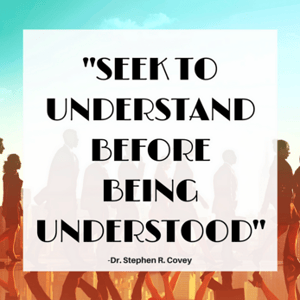Don't Say "Coffee" When You Mean "Consultation"
"Let's grab coffee" was the subject line of the message I received on LinkedIn. The sender wrote, "I'm new to my position here at XYZ Company, I saw your profile and hoped we could get to know one another." Since coffee happens to be one of my BFF's, and since a look at his profile indicated he might be good to know, I gladly obliged his request.
We decided to meet at my office; so, I had our Senior VP of All Things Coffee brew up a fresh pot. Upon his arrival, he declined my offer for a cup of coffee (blasphemy) AND, once we were seated in the conference room, he opened the meeting with something along the lines of, "So, today isn't going to cost you anything. It's a free consultation."  If you've ever taken a big gulp of what you thought was water only to realize it's lemon-lime soda, then you can relate to how I felt at that moment. I mean, kudos to him for trying to set expectations for our conversation on the front end of the meeting but based on the initial "I'm just trying to get to know people" message, it sure felt like a bait and switch — which is never a good way to begin a relationship, especially with a prospect (which he obviously thought I was)!
If you've ever taken a big gulp of what you thought was water only to realize it's lemon-lime soda, then you can relate to how I felt at that moment. I mean, kudos to him for trying to set expectations for our conversation on the front end of the meeting but based on the initial "I'm just trying to get to know people" message, it sure felt like a bait and switch — which is never a good way to begin a relationship, especially with a prospect (which he obviously thought I was)!
The golden rule of selling is 'Sell unto others as you'd have them sell unto you!' Selling doesn't have to be slimy or misleading; in fact, it should never be slimy or misleading. The job of a sales person is to help their prospects find the best solution to their problem, even if it means losing the sale. But hopefully it means you offer the best solution and can earn the prospect's trust in the process of helping them while also having an opportunity to fully understand the problem they need to solve.
I've had the pleasure of learning a thing or three from a couple of stellar sales coaches: Hubspot's David Weinhaus and Andrew Gieselmann, owner of Sandler Training by Capstone Sales Performance.
Here are a few important takeaways...
Set an agenda, use an up-front contract, and stick to it!
Ask your prospect what they hope to achieve in your meeting, and listen. Then, let them know what your goals are for the meeting and make sure they are okay with those goals. This also gives you an opportunity to manage their expectations if their goals for the meeting aren't in line with what you can accomplish. If you really want to get ahead of the game, set some expectations prior to your meeting to make sure you're on the same page, then revisit them at the start of your meeting. Your prospect may be expecting a slide deck and proposal, but you're planning to ask them 100 questions, which you'll need answers to before you can even think about putting a proposal together.
Go for No!
Here's a page straight out of Andrew's playbook: "Unless you want unlimited access to voicemail, go for the no!" The simple fact is, no one likes being the bearer of bad news; so our prospects often avoid us because they're just too nice to tell us "No." Give your prospect permission to say, at anytime, that you aren't a good fit AND ask for their permission to do the same. This small exchange can help you avoid being strung along and allows their guard to come down so that you can truly understand what's at stake for them and if/how you can help.
Bonus: By giving them permission to tell us no, it also gives us an opportunity to understand why it's a no. That's really valuable for a couple of reasons: 1. If it was a good fit in your eyes, you can understand why it wasn't in theirs. Then, if you need to make a change going forward, you can. 2. Allowing them to tell you no gives you the opportunity to overcome that no — IF that's what's truly best for the prospect.
Understand the goals, timing, and needs of your prospects. Be naturally curious and seek to truly understand WHY they need to make a change in order to reach their goals.
Doing this is an easy segue to the next thing on our list...
Focus on the problem first, not the solution.

In the HubSpot Sales Skills Bootcamp, David calls this "Finding The GAP." It's in our nature to avoid problems; it's natural to head for a solution first, but it's critical to figure out why the problem is the problem or, more importantly, if the problem the prospect presents is actually the root cause of their issues.
Here's an analogy I like to use to make sense of this focusing on the problem to my prospects: If you go to the doctor and tell him you have strep throat, he's not going to just take your word for it. He's going to dig a little deeper, look down your throat, swab it, and run some tests. If he simply took your word for it and recommended a course of treatment that didn't cure your illness, you'd be back in his office mad that he didn't do his due diligence as the expert you trusted him to be. In order to make sure you're providing the solution your prospect actually needs, you must take a deep dive into the problem.
Here's David explaining "Find The GAP"
And finally, let's finish with a video that is atrociously amazing!
.webp?width=12693&height=4513&name=Sauce%20Logo%20Dark%20Ht%20(1).webp)

.webp?width=180&height=64&name=Sauce%20Logo%20Dark%20Ht%20(1).webp)











